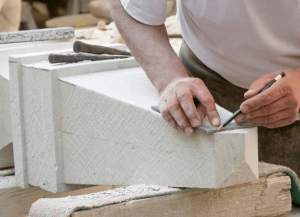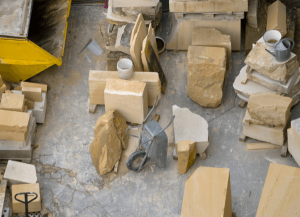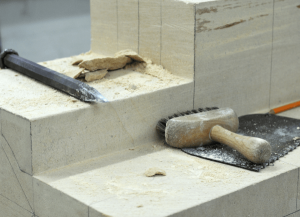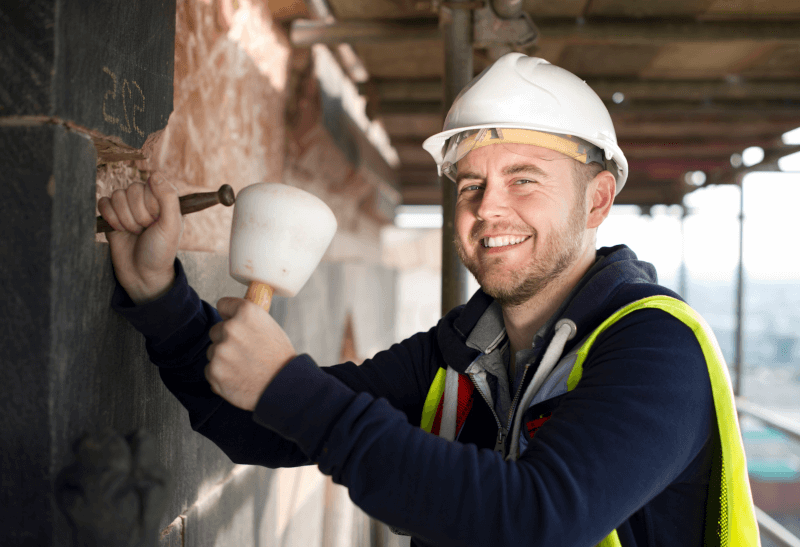Masonry is one of the world’s oldest methods of construction. Many of the world’s famous monuments were constructed with masonry skills, including the Egyptian pyramids and the Great Wall of China. Over the years, we have developed different masonry techniques, so what are the different styles of masonry?
The two main styles of masonry are solid masonry and veneer masonry. To break up masonry further, we turn to the materials used. Sub-categories of masonry include brick, stone, concrete, composite, gabion, and reinforced masonry. Each require special knowledge of the material and best masonry style.
Read on to learn more about these different styles of masonry.
What is masonry?
We can mainly divide masonry into two different styles: veneer masonry and solid masonry.
Construction masonry is the art of constructing buildings using materials such as stone, bricks, and concrete with mortar. Masonry is initially divided into two styles – veneer masonry and solid masonry. Most structures will involve a bit of one of these styles of masonry somewhere along the way. For example, bridges, walls, and pillars can use masonry. Also, stairs, canals, barrages, dams, and more. This will depend on the style and material planned to use for the structures. But any that involve bricks, stone, or concrete will require some masonry skills.
 Masonry is one of the oldest methods of construction that has been used by almost all countries around the world. Masonry combines two types of materials: the blocks and the substance to bind these blocks, keeping structures in place. As we mentioned, the blocks are made of materials such as brick, stone, marble, and concrete. The binding materials can be clay, limestone, and mortar.
Masonry is one of the oldest methods of construction that has been used by almost all countries around the world. Masonry combines two types of materials: the blocks and the substance to bind these blocks, keeping structures in place. As we mentioned, the blocks are made of materials such as brick, stone, marble, and concrete. The binding materials can be clay, limestone, and mortar.
Masonry is an area of construction that a labourer can specialise in. They can either choose one specific area of masonry, such as becoming a brick mason. But often they will learn as much as possible about masonry entirely, to then be able to apply more skills to different projects. By pairing lots of masonry knowledge with quality masonry tools, a labourer can deliver excellent structures that could last centuries. We say centuries because, as we mentioned, well-done masonry has been used throughout history to build some of the most famous structures.
Both styles of masonry will involve carving heavy materials to fit and act as an aesthetically appealing feature for structures. Whether solid or veneer masonry, you will need to practice your carving skills. It can become very technical and require a lot of patience, but the results include magnificent decorative carvings. This makes masonry more than a construction skill, but also a form of art.
Let’s learn more about the different styles of masonry that have been developed.
Veneer masonry vs solid masonry
We can mainly divide masonry into two different styles: veneer masonry and solid masonry
The main two categories of masonry are veneer masonry and solid masonry. One is more for appearance, whereas the other also contributes to the structural integrity of a building. Both styles of masonry have advantages, depending on what you are seeking.
Veneer masonry
Veneer masonry offers the appearance of solid masonry but doesn’t cost as much. Veneer masonry involves constructing a non-structural external layer of masonry, usually made from brick or stone. This style of masonry is found on the outer walls of houses and commercial buildings. The veneer masonry is attached to the building but is for appearance purposes. It doesn’t have a load-bearing function which means it isn’t used as the main supporting point for a building. It will weigh less than solid masonry because it is only an outer layer. To explain this more: the supporting wall is often made of wood, then a layer of brick is built around the outside for appearance purposes. The benefit to veneer masonry is that you can achieve a smooth masonry finish without the cost of solid masonry.
Solid masonry
Solid masonry has been the more popular style of masonry over the years. Some of the world’s oldest buildings were constructed with solid masonry techniques. Solid masonry is used to create a structure and can provide support and load-bearing functions. This also allows the areas of masonry to be free-standing if you wish. By combining the solid building technique with the heavy materials of stone and bricks, solid masonry structures can stand for hundreds of years. This is part of why many houses were originally built with stone. The advantages of stone houses largely came from their solid masonry build and were a way to display wealth because the material is so long-lasting.
Styles of masonry based on materials
Masonry styles can also differ depending on the materials used. Below we’re going to talk about six main styles of masonry based on building materials.
Stone Masonry
Stone masonry uses different types of stones such as granite, sandstones, cast stones, and marble. Mortar of cement and limestone are the best binding materials for stone. Both dressed stones and undressed stone can be used for stone masonry. Dressed stones have fine joints and give a finer finish. Undressed stone (rough stone) has a more textured appearance keeping the authentic look of stone before it has been smoothed.
Stone masonry is one of the strongest masonry styles, being more durable than brick and block masonry. It’s water-resistant and often requires little repair and maintenance. There are professional stonemasons that will provide excellent finishes if this is the direction you choose to take.
Brick Masonry
Brick masonry is a very popular masonry style, with bricks being our most common building material. A variety of different bricks can be used for brick masonry, with brick masons having the knowledge of different brick classes and qualities. Classic bricks, fly-ash bricks, concrete bricks, and engineering bricks are just a few different types that brick masons can use. Kiln burnt bricks are the most common brick used.
Bricks are usually lighter than most other masonry materials such as stone and concrete blocks. They do have the durability to last for decades and can be easier and faster to place than other masonry materials. Brick masonry can also have a lower cost than stonemasonry given the differences in the materials.
Block Masonry/Concrete Masonry
Like with bricklaying, concrete masonry follows a staggered pattern. But as blocks are larger than bricks, it is less time-consuming than bricklaying. Concrete blocks also tend to be affordable. Another speciality of concrete blocks is that they are fire-resistant.
Block masonry uses concrete blocks to build structures. Concrete blocks can be more affordable than other masonry materials and they are fire-resistant, which makes them popular for use in larger buildings.
The concrete blocks are made by pouring liquid concrete into a frame chamber and compressing it. Compression improves the compaction and strength of the blocks. There are also different kinds of concrete blocks. These include hollow, corner, stretcher, and pillar blocks. They also come in a variety of shapes and sizes. This means that each block will have specific aspects of the two masonry styles that will be combined to create the masonry structure.
Composite Masonry
Composite masonry combines two or more types of materials. For example, a wall built with bricks could have stones on the facing. Or a wall built with concrete could have a brick facing. Composite masonry is used to improve the appearance of a building while strengthening its structure and durability. Using materials such as stone and marble for the outer surface of structures can help to prevent weathering and provide protection against water and chemicals.
Composite masonry will combine styles of masonry given that you will also be combining materials. It does mean that your structure could be finished sooner as you won’t be waiting on extra loads of one material.
Gabion Masonry
Gabions are boxes or cages of galvanized steel wires that are filled with stones of medium size. The wires prevent the stones from dismantling. Gabions act as units and are stacked to form a retaining wall. Most gabion walls slope back so that stones do not exert pressure on the wires.
Gabion masonry is flexible and allows good draining. It is resistant to flood, frost damage, soil flow, and horizontal pressure. Their durability stems from the durability of the wires. So, the wires should be made of corrosion-resistant material, especially for use in severe climatic conditions.
Reinforced Masonry
Reinforced masonry involves using steel rods or cables within a concrete structure. Using reinforcement in masonry increases the strength of a structure and can help resist lateral loading better than regular masonry. The reinforced style of masonry allows for some deformation under the load of the structure. Because of this, the cost is higher than other masonry styles but can be beneficial in the long run. This is because as the structure moves slightly over time, you’re assured that your masonry will hold strong.
The style of masonry for your construction project will depend on whether you’re wanting solid or veneer masonry and the materials you want to use. With this base knowledge of the styles of masonry, you can begin brainstorming your ideas and then finalise them with a professional mason’s opinion. The range of styles should allow you to have the masonry finish you’re looking for no matter the project, so enjoy the planning process!
For more home, bricklaying and masonry answers, check out our Paragon Tools resources. We cover questions such as ‘is masonry a good trade?’ and ‘is brick a good insulator?’. For quality bricklaying and masonry tools, visit our Paragon Tools shop.



